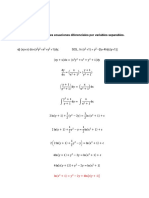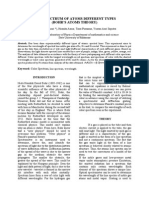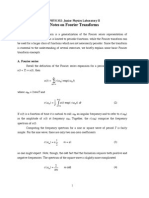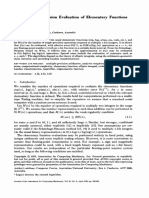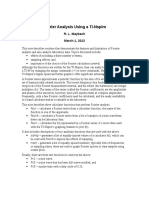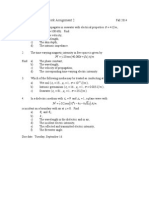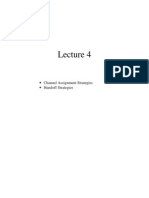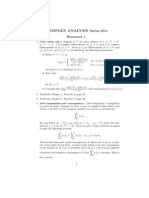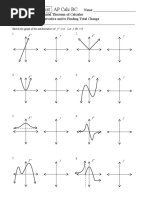Notes 07. Fourier Series Errors
Notes 07. Fourier Series Errors
Uploaded by
Jean ReneCopyright:
Available Formats
Notes 07. Fourier Series Errors
Notes 07. Fourier Series Errors
Uploaded by
Jean ReneOriginal Description:
Copyright
Available Formats
Share this document
Did you find this document useful?
Is this content inappropriate?
Copyright:
Available Formats
Notes 07. Fourier Series Errors
Notes 07. Fourier Series Errors
Uploaded by
Jean ReneCopyright:
Available Formats
7.
Error in Fourier Series
Nurgun Erdol
10Feb09
In the last section, we studied the Fourier series expansion of a rectangular wave which is also
called a square wave even when it is not square. We obtained the Fourier series coefficients
analytically using integrals; and we verified the results numerically by building the rectangular
signal from the harmonics in the Fourier series. The first five of these are shown in Figure . The
first row figures are identical, because they both show the !" term, equal to a constant given by
the coefficient
o
a
. It is also the signal#s $ero%order approximation. The second row shows the first
harmonic in the left column. &ote that it has a period of ' which is the period of the signal. The
second column is the first%order approximation which is the sum of the two harmonics. Third
row#s left column shows the third harmonic, and the right column shows the sum of the three
harmonics shown. &ote that the third harmonic has a period that is () of that of the first
harmonic and hence its frequency is three times that of the first. I s*ipped the second one
because it is $ero. +,lease chec* the preceding set of notes.- The last row shows the seventh
harmonic on the left and the seventh%order approximation on the right. We can already see a
rectangular shape forming.
-4 -2 0 2 4
-2
0
2
Harmonics of the Square Wave in Example 4
-4 -2 0 2 4
-2
0
2
The approximations of the Square Wave in Example 4
-4 -2 0 2 4
-0.5
0
0.5
-4 -2 0 2 4
0
0.5
1
-4 -2 0 2 4
-0.2
0
0.2
-4 -2 0 2 4
0
0.5
1
-4 -2 0 2 4
-0.1
0
0.1
-4 -2 0 2 4
0
0.5
1
-4 -2 0 2 4
-0.1
0
0.1
time (s)
-4 -2 0 2 4
0
0.5
1
time (s)
Figure 1. Approximations (right column) and their associated harmonics (let column) obtained rom the
Fourier series o a s!uare "a#e.
In Figure ' and Figure ) are displayed the square wave and its third and seventh order
approximations superimposed on the same set of axes. The red ones are the approximations and
the one in Figure ) is $oomed in for visibility. What you should notice is a- the seventh
approximation is closer to the square wave at most points than the third approximation, b- the
value of both approximations +third and seventh order- at the edges of the square wave, e.g. at
( ',( ', )( ' etc t =
stays the same and it stays at ., and c- the maximum deviation of the
approximations from the square wave aren#t changing. /ou can observe these better on many
more approximations by running the m%file called Notes0$ExerciseNo%&&and&'and'.m. 0
discussion of these observations is next.
-4 -3 -2 -1 0 1 2 3 4
-0.2
0
0.2
0.4
0.6
0.8
1
time (s)
Square wave and its third order approximation
Figure (. )he s!uare "a#e and its third order approximation (in red).
-0.5 0 0.5 1 1.5 2 2.5
-0.2
0
0.2
0.4
0.6
0.8
1
time (s)
Square wave and its seventh order approximation
Figure *. S!uare "a#e and its se#enth+order approximation (in red).
'
Approximation Errors
The Fourier series equates a periodic function to a sum of sinusoids according to the
equation
+ - cos+' - sin+' -
o n o n o
n n
x t a a nf t b nf t
= =
= + +
.
1ne can always question an assertion li*e that, so Fourier had to prove that indeed the right hand
side +234- is 5equal6 to the left hand side +734- for any
+ - x t
that satisfies the !irichlet
conditions given in Notes 06. Periodic Functions and the Fourier Series.doc. 3is rigorous proof
is beyond the scope of this course. 3owever, we can intuitively and with the help of computation
touch on most of the significant points of the proof.
If ( ) + - 8.9cos+' : - 8.;sin ' : x t t t = + +
, then the 234 defines
+ - x t
, which means that
for every
t
, what one calculates on the 234 is what
+ - x t
is. The error, defined as the difference
of the two sides ( ) ( ) ( )
+ - 8.9cos+' : - 8.;sin ' : e t x t t t = + +
is 8 for every
t
. 3ence the
energy in the error signal is also 8. 2ecall that energy is the integral of the squared signal, which
in this case is the error. The problem becomes more difficult when for a given
+ - x t
the 234 of
has infinitely many terms, such as in this example of the square wave. In this case, the equality is
proven by studying the behavior of approximations with a finite number of terms as the number
of terms is increased to infinity. 3ence we define the N
th
order approximation to
+ - x t
as
+ - cos+' - sin+' -
N N
N o n o n o
n n
x t a a nf t b nf t
= =
= + +
which gives rise to the N
th
order approximation error
( ) + - + -
N N
e t x t x t =
.
Figure : is divided into three rows and three columns. <ach column has the same order N which
is ,) and : from left to right. The top row shows the N
th
harmonic for the square wave. It is a
cosine of frequency N . &ote that all plots are drawn for 9 9 t < < . 1ver the same duration,
the first harmonic has 9 cycles, the third harmonic has ' cycles which is ) times as many as the
first. The :
th
harmonic has '8 cycles, which is : times as many as that of the first. The second
row shows the N
th
approximation. The rectangular shape of the approximation is beginning to
emerge for &=) and loo*s closer to it for &=:. &ote that &=: has more ripples +) in per on%
cycle around and ) in the off cycle around 8- than the third order approximation which has '
and the first order which has . The ripples may be seen in the last row where the error
+ -
N
e t
is
plotted.
To evaluate the error, and to see the changes in it, I have plotted them in Figure : over a
shorter duration and for
, ), :, >, ? N =
. 7et#s first focus on the values at 8 t = where ( ) x t =
.
+8- 8.)@@, 8.8>:@, 8.8:>, 8.8)?', 8.8):.
N
e =
for
, ), :, >, ? N =
. 1ne can deduce, of course
observing data for many more values of &, that
lim +8- 8
N
N
e
=
, that is the error at 8 oscillate
around 8 but getting closer and closer to it with each &. &ow let#s do the same for 8.' t = and
)
-4 -2 0 2 4
-1
-0.5
0
0.5
1
time (s)
Harmonic number 1
-4 -2 0 2 4
-0.5
0
0.5
1
1.5
1-th order approximation
time (s)
-4 -2 0 2 4
-1
-0.5
0
0.5
1
The 1-th order approximation error signal
time (s)
-4 -2 0 2 4
-0.4
-0.2
0
0.2
0.4
time (s)
Harmonic number 3
-4 -2 0 2 4
-0.5
0
0.5
1
1.5
3-th order approximation
time (s)
-4 -2 0 2 4
-1
-0.5
0
0.5
1
The 3-th order approximation error signal
time (s)
-4 -2 0 2 4
-0.2
-0.1
0
0.1
0.2
time (s)
Harmonic number 5
-4 -2 0 2 4
-0.5
0
0.5
1
1.5
5-th order approximation
time (s)
-4 -2 0 2 4
-1
-0.5
0
0.5
1
The 5-th order approximation error signal
time (s)
Figure ,. For approximation orders 1- * and .(rom let to right) are sho"n a) the harmonics (top ro")-
b)approximations ( )
N
x t (second ro") and c) approximation error signal ( )
N
e t (third ro") is the dierence
bet"een the s!uare "a#e and the second ro".
and 8.; t = . The numbers are little different but we still deduce that
lim + - 8
N
N
e t
=
for 8.' t = and
8.; t = . The picture changes at 8.: t = , which is a point of discontinuity of ( ) x t
. When you
approach the discontinuity from the right, you get % for all &. It doesn#t change. When you
approach the discontinuity from the left, you get and it doesn#t change with &, either. &ow if
you switch your attention to Figure @, you see that the approximation ( )
N
x t
is always 8.: at
t=8.:. This explains the behavior of the error signal. 0lso observe in Figure @, that the maximum
over 8 8.: t < < of ( )
N
x t
is at t=8 for N=, and moves to
8.':, 8.)), 8.)?, 8.9 t =
for N=),:,>,?.
that is to say that the pea* migrates toward the location of the discontinuity. This is one more
observation that as ( ) ( ) as
N
x t x t N
for all
t
that does &1T support a discontinuity. 0t
points of discontinuity of the square wave function of this example, ( ) 8.:
N
x t =
for all N. 4ince
the sustained error is of finite value equal to 8.: and only occurs at isolated points, its
contribution to the total error energy is 8. 2emember the error energy per cycle is the integral of
( )
'
N
e t
over period.
9
-1 -0.8 -0.6 -0.4 -0.2 0 0.2 0.4 0.6 0.8 1
-0.5
-0.4
-0.3
-0.2
-0.1
0
0.1
0.2
0.3
0.4
0.5
time (s)
Approximation error signals orders 1,3,5,7,9
order 1
order 3
order 5
order 7
order 9
Figure .. Approximation errors o odd orders 1 through 9 displa/ed or one period.
-1 -0.8 -0.6 -0.4 -0.2 0 0.2 0.4 0.6 0.8 1
-0.4
-0.2
0
0.2
0.4
0.6
0.8
1
1.2
time (s)
Approximation signals of orders 1,3,5,7,9
order 1
order 3
order 5
order 7
order 9
Figure $. Approximations o orders 1-*-.-7-9 to the s!uare "a#e signal.
:
The mean%square error +mse- is equal to the error energy divided by the period. It can be
approximated numerically by the sum of the square of the error signal at samples over a period.
The mse of the error specified as a function of the continuous variable t is given by the integral
( )
'
'
N N
e t dt
.
1f course equation is for the square wave we are analy$ing and the limits will change and factor
of . will be replaced with (T for other examples where T is the signal period. The
computational approximation to may be given by
( ) ( )
'
'
M
N N k
k M
t e t
=
where the samples ( )
k
t k t =
and ( ) ( M t =
if it is an integer. <quation is derived from a
representation of ( )
'
N
e t
in terms of rectangles that are t wide and are of height equal to ( )
'
N k
e t
.
Asing ( ) M t =
, it is easy to show that <quation may be written as
( )
'
'
M
N N k
k M
e t
M
.
The 234 of <quation is plotted for the example square wave and shown in Figure >. the figure
shows that the mse goes to 8 as N gets large.
0 10 20 30 40 50 60
0
0.005
0.01
0.015
0.02
0.025
0.03
0.035
0.04
0.045
0.05
mean-square error
Harmonic number
Figure 7. 0ean+s!uare error computed or the s!uare "a#e or N11 to .1.
@
Summar/ o errors
4pecific data refer to the square wave example. 0ll others are general.
. ,oint%wiseB The error signal goes to $ero everywhere but at the points of discontinuity.
For all
t
other than points of discontinuity +e.g. { } ( ', )( ', :( ' t K
-
( ) ( ) lim
N
N
x t x t
=
'. ,oint%wiseB 0t a point of discontinuity, there is a sustained error equal to . the difference
of the two sides of the discontinuity. The Fourier series is said to converge to the mean or
average value of the right and left limits of the discontinuity. 0t points of discontinuity,
+e.g. { } ( ', )( ', : ( ' t = K
-
( ) ( ) ( ) ( )
( )
( ) ( )
8.:
8.:
8.:, 8.:
N left right
N
N left N right
x t x t x t general
x t square wave
e t e t square wave
= +
=
= =
K
K
K
where ( )
left
x t
is the value of ( ) x t
to the left of the discontinuity and ( )
right
x t
is its value to the
right.
). The mean square error always converges to 8, i.e.
lim 8
N
N
=
>
You might also like
- Kevin Dennis and Steven Schlicker - Sierpinski N-GonsNo ratings yetKevin Dennis and Steven Schlicker - Sierpinski N-Gons7 pages
- Signal Analysis: 1.1 Analogy of Signals With VectorsNo ratings yetSignal Analysis: 1.1 Analogy of Signals With Vectors29 pages
- Space (Park) Vectors Definition of Space Vectors:: T X A T X A T X T XNo ratings yetSpace (Park) Vectors Definition of Space Vectors:: T X A T X A T X T X19 pages
- MA124 Maths by Computer Week 8 Assignment: Solution 8A:Root FindingNo ratings yetMA124 Maths by Computer Week 8 Assignment: Solution 8A:Root Finding14 pages
- Estimating The Number of Modes in Multimode Waveguide Propagation EnvironmentNo ratings yetEstimating The Number of Modes in Multimode Waveguide Propagation Environment4 pages
- Kinematics and Dynamics, An Analytic ApproachNo ratings yetKinematics and Dynamics, An Analytic Approach157 pages
- Time and Frequency Analysis of Discrete-Time SignalsNo ratings yetTime and Frequency Analysis of Discrete-Time Signals16 pages
- 1.4 Signal Power: Time (Seconds) Frequency (HZ)No ratings yet1.4 Signal Power: Time (Seconds) Frequency (HZ)9 pages
- Fourier Analysis - Introduction From A Practical Point of ViewNo ratings yetFourier Analysis - Introduction From A Practical Point of View8 pages
- Section IV.5: Recurrence Relations From AlgorithmsNo ratings yetSection IV.5: Recurrence Relations From Algorithms9 pages
- An Optimal Balancing Structure For Small and Medium Electrical Machine RotorsNo ratings yetAn Optimal Balancing Structure For Small and Medium Electrical Machine Rotors9 pages
- COMPUTATIONAL FLUID DYNAMICS - Anderson, Dale A. Computational Fluid Mechanics and Heat Transfer100-150No ratings yetCOMPUTATIONAL FLUID DYNAMICS - Anderson, Dale A. Computational Fluid Mechanics and Heat Transfer100-15050 pages
- 1992 04 Application Od Uniform Linear Array Bearing Estimation Techniques To Uniform Circular Arrays PDFNo ratings yet1992 04 Application Od Uniform Linear Array Bearing Estimation Techniques To Uniform Circular Arrays PDF4 pages
- Uo (W), Vo (W, UO (W) : T2 (W) Are Given by W 2, V 0 (W) w2No ratings yetUo (W), Vo (W, UO (W) : T2 (W) Are Given by W 2, V 0 (W) w24 pages
- Fourier Algorithms: S. A. Soman Department of Electrical Engineering, IIT BombayNo ratings yetFourier Algorithms: S. A. Soman Department of Electrical Engineering, IIT Bombay34 pages
- Sixth Term Examination Papers Mathematics 3: Monday 23 June 2008No ratings yetSixth Term Examination Papers Mathematics 3: Monday 23 June 20088 pages
- Linear Time Invariant Systems: (N), and IsNo ratings yetLinear Time Invariant Systems: (N), and Is12 pages
- The Exponential Form of The Fourier Series100% (1)The Exponential Form of The Fourier Series28 pages
- Notes On Fourier Transforms: PHYS 332: Junior Physics Laboratory IINo ratings yetNotes On Fourier Transforms: PHYS 332: Junior Physics Laboratory II6 pages
- Circuits With Time-Varying Parameters: (Modulators, Frequency-Changers and Parametric Amplifiers)No ratings yetCircuits With Time-Varying Parameters: (Modulators, Frequency-Changers and Parametric Amplifiers)9 pages
- Fourier Analysis Using A TI-Nspire: R. L. Maybach March 1, 2013No ratings yetFourier Analysis Using A TI-Nspire: R. L. Maybach March 1, 201321 pages
- The Fundamental Theorem of Calculus and The Poincaré LemmaNo ratings yetThe Fundamental Theorem of Calculus and The Poincaré Lemma13 pages
- Numerical Methods Final Requirements ShshsiwzbNo ratings yetNumerical Methods Final Requirements Shshsiwzb10 pages
- Student Solutions Manual to Accompany Economic Dynamics in Discrete Time, secondeditionFrom EverandStudent Solutions Manual to Accompany Economic Dynamics in Discrete Time, secondedition4.5/5 (2)
- 3 Tektronix Test Challenges in A Multi-Domain IoT WorldNo ratings yet3 Tektronix Test Challenges in A Multi-Domain IoT World31 pages
- EEL 5934 Homework Assignment 2 Fall 2014No ratings yetEEL 5934 Homework Assignment 2 Fall 20141 page
- Notes 01. Scaling and Shifting 1D FunctionsNo ratings yetNotes 01. Scaling and Shifting 1D Functions3 pages
- MAP 6264 Homework 4 (Finite-Source Input, BCC) 30 PointsNo ratings yetMAP 6264 Homework 4 (Finite-Source Input, BCC) 30 Points2 pages
- Channel Assignment Strategies - Handoff StrategiesNo ratings yetChannel Assignment Strategies - Handoff Strategies7 pages
- EEL 6935-Wireless PCS Homework #1: SolutionNo ratings yetEEL 6935-Wireless PCS Homework #1: Solution5 pages
- Mathematics 113, Problem Set 3 Solutions: Alexander P. EllisNo ratings yetMathematics 113, Problem Set 3 Solutions: Alexander P. Ellis3 pages
- Complex Analysis-: Spring 2014 Homework 1No ratings yetComplex Analysis-: Spring 2014 Homework 12 pages
- Matching Supply With Demand: Course DescriptionNo ratings yetMatching Supply With Demand: Course Description4 pages
- 12XM ARMCQ - Continuty and Differentiability CBSENo ratings yet12XM ARMCQ - Continuty and Differentiability CBSE5 pages
- 67 Determination of Sugars and Sorbitol (HPLC) Rev 2005No ratings yet67 Determination of Sugars and Sorbitol (HPLC) Rev 20055 pages
- Pad e and Hermite-Pad e Approximation and Orthogonality: Walter Van AsscheNo ratings yetPad e and Hermite-Pad e Approximation and Orthogonality: Walter Van Assche31 pages
- Dr. Javeria Ayub Applied Mathematics & StatisticsNo ratings yetDr. Javeria Ayub Applied Mathematics & Statistics20 pages
- 3 - BC 2017-18 5.-6.3 FTC To Sketch and Find Total ChangeNo ratings yet3 - BC 2017-18 5.-6.3 FTC To Sketch and Find Total Change6 pages
- An Overview and Comparison of Software Reliability Tools: Dileep Sadhankar, Dr. Ashish SasankarNo ratings yetAn Overview and Comparison of Software Reliability Tools: Dileep Sadhankar, Dr. Ashish Sasankar5 pages
- Linear Programming Test Bank An IntroducNo ratings yetLinear Programming Test Bank An Introduc15 pages
- "Just The Maths" Unit Number 14.9 Partial Differentiation 9 (Taylor's Series) For (Functions of Several Variables) by A.J.HobsonNo ratings yet"Just The Maths" Unit Number 14.9 Partial Differentiation 9 (Taylor's Series) For (Functions of Several Variables) by A.J.Hobson6 pages
- Practical Research 1: Quarter 2 - Module 6: Analyzing The Meaning of The Data and Drawing Conclusion75% (4)Practical Research 1: Quarter 2 - Module 6: Analyzing The Meaning of The Data and Drawing Conclusion19 pages
- RMCF0024 A-Measurement Inspection Request - #644014001 - GaugeNo ratings yetRMCF0024 A-Measurement Inspection Request - #644014001 - Gauge1 page
- Kevin Dennis and Steven Schlicker - Sierpinski N-GonsKevin Dennis and Steven Schlicker - Sierpinski N-Gons
- Signal Analysis: 1.1 Analogy of Signals With VectorsSignal Analysis: 1.1 Analogy of Signals With Vectors
- Space (Park) Vectors Definition of Space Vectors:: T X A T X A T X T XSpace (Park) Vectors Definition of Space Vectors:: T X A T X A T X T X
- MA124 Maths by Computer Week 8 Assignment: Solution 8A:Root FindingMA124 Maths by Computer Week 8 Assignment: Solution 8A:Root Finding
- Estimating The Number of Modes in Multimode Waveguide Propagation EnvironmentEstimating The Number of Modes in Multimode Waveguide Propagation Environment
- Time and Frequency Analysis of Discrete-Time SignalsTime and Frequency Analysis of Discrete-Time Signals
- Fourier Analysis - Introduction From A Practical Point of ViewFourier Analysis - Introduction From A Practical Point of View
- Section IV.5: Recurrence Relations From AlgorithmsSection IV.5: Recurrence Relations From Algorithms
- An Optimal Balancing Structure For Small and Medium Electrical Machine RotorsAn Optimal Balancing Structure For Small and Medium Electrical Machine Rotors
- COMPUTATIONAL FLUID DYNAMICS - Anderson, Dale A. Computational Fluid Mechanics and Heat Transfer100-150COMPUTATIONAL FLUID DYNAMICS - Anderson, Dale A. Computational Fluid Mechanics and Heat Transfer100-150
- 1992 04 Application Od Uniform Linear Array Bearing Estimation Techniques To Uniform Circular Arrays PDF1992 04 Application Od Uniform Linear Array Bearing Estimation Techniques To Uniform Circular Arrays PDF
- Uo (W), Vo (W, UO (W) : T2 (W) Are Given by W 2, V 0 (W) w2Uo (W), Vo (W, UO (W) : T2 (W) Are Given by W 2, V 0 (W) w2
- Fourier Algorithms: S. A. Soman Department of Electrical Engineering, IIT BombayFourier Algorithms: S. A. Soman Department of Electrical Engineering, IIT Bombay
- Sixth Term Examination Papers Mathematics 3: Monday 23 June 2008Sixth Term Examination Papers Mathematics 3: Monday 23 June 2008
- Notes On Fourier Transforms: PHYS 332: Junior Physics Laboratory IINotes On Fourier Transforms: PHYS 332: Junior Physics Laboratory II
- Circuits With Time-Varying Parameters: (Modulators, Frequency-Changers and Parametric Amplifiers)Circuits With Time-Varying Parameters: (Modulators, Frequency-Changers and Parametric Amplifiers)
- Fourier Analysis Using A TI-Nspire: R. L. Maybach March 1, 2013Fourier Analysis Using A TI-Nspire: R. L. Maybach March 1, 2013
- The Fundamental Theorem of Calculus and The Poincaré LemmaThe Fundamental Theorem of Calculus and The Poincaré Lemma
- Student Solutions Manual to Accompany Economic Dynamics in Discrete Time, secondeditionFrom EverandStudent Solutions Manual to Accompany Economic Dynamics in Discrete Time, secondedition
- 3 Tektronix Test Challenges in A Multi-Domain IoT World3 Tektronix Test Challenges in A Multi-Domain IoT World
- MAP 6264 Homework 4 (Finite-Source Input, BCC) 30 PointsMAP 6264 Homework 4 (Finite-Source Input, BCC) 30 Points
- Channel Assignment Strategies - Handoff StrategiesChannel Assignment Strategies - Handoff Strategies
- Mathematics 113, Problem Set 3 Solutions: Alexander P. EllisMathematics 113, Problem Set 3 Solutions: Alexander P. Ellis
- 67 Determination of Sugars and Sorbitol (HPLC) Rev 200567 Determination of Sugars and Sorbitol (HPLC) Rev 2005
- Pad e and Hermite-Pad e Approximation and Orthogonality: Walter Van AsschePad e and Hermite-Pad e Approximation and Orthogonality: Walter Van Assche
- 3 - BC 2017-18 5.-6.3 FTC To Sketch and Find Total Change3 - BC 2017-18 5.-6.3 FTC To Sketch and Find Total Change
- An Overview and Comparison of Software Reliability Tools: Dileep Sadhankar, Dr. Ashish SasankarAn Overview and Comparison of Software Reliability Tools: Dileep Sadhankar, Dr. Ashish Sasankar
- "Just The Maths" Unit Number 14.9 Partial Differentiation 9 (Taylor's Series) For (Functions of Several Variables) by A.J.Hobson"Just The Maths" Unit Number 14.9 Partial Differentiation 9 (Taylor's Series) For (Functions of Several Variables) by A.J.Hobson
- Practical Research 1: Quarter 2 - Module 6: Analyzing The Meaning of The Data and Drawing ConclusionPractical Research 1: Quarter 2 - Module 6: Analyzing The Meaning of The Data and Drawing Conclusion
- RMCF0024 A-Measurement Inspection Request - #644014001 - GaugeRMCF0024 A-Measurement Inspection Request - #644014001 - Gauge

